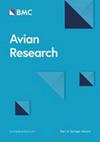替代食物丰度和可得性对越冬西伯利亚鹤觅食行为的影响
IF 1.7
2区 生物学
Q1 ORNITHOLOGY
引用次数: 0
摘要
食物丰度和可用性是水鸟觅食栖息地质量的基本决定因素,高质量的觅食栖息地在支持越冬种群的生存和年生命周期中起着至关重要的作用。最佳栖息地的持续退化和丧失迫使越冬水鸟越来越依赖于其他觅食地点,并改变它们的行为适应策略来应对食物短缺。西伯利亚鹤(Leucogeranus Leucogeranus)是一种大型濒危水鸟,具有特殊的饮食偏好,对环境变化表现出特别的敏感性。面对栖息地的减少和自然食物资源的减少,该物种逐渐适应利用人工栖息地,包括水田和荷塘等农业景观,作为补充的越冬觅食地,以满足它们的能量需求。本研究探讨了在有限食物供应条件下,西伯利亚鹤在人工栖息地通过可塑性行为策略来调整其觅食行为,从而提高种群适应性的假设。对2023 ~ 2024年越冬期间泥滩和荷塘鹤的觅食行为进行了比较分析。本研究聚焦于三个关键环境因素:食物丰度、食物埋藏深度和沉积物渗透性,研究它们对这些不同栖息地觅食模式的影响。结果显示了显著的生境间差异:觅食成功率明显较高(p <;与泥滩相比,荷塘的食物处理次数明显增加,而泥滩生境的觅食次数和尝试次数显著增加。荷塘优越的食物供应提高了鹤的觅食成功率,使鹤能够为冬季生存积累必要的能量储备。然而,在这些生境中,更深的埋藏深度需要更密集的加工行为,包括长时间的挖掘、破碎和吞咽活动,因此与泥滩条件相比,处理时间增加了约40%,觅食次数减少了25-30%。这些行为权衡表明,虽然荷塘提供了充足的食物资源,但其结构特征可能会施加生理限制,限制其作为西伯利亚鹤最佳觅食地的有效性。这些发现为揭示越冬西伯利亚鹤对食物资源分布空间变化的行为可塑性提供了有价值的见解,同时也有助于我们了解莲藕作为人工湿地生态系统冬季食物替代来源的生态价值。本文章由计算机程序翻译,如有差异,请以英文原文为准。
The influence of the abundance and availability of alternative food on the foraging behavior of wintering Siberian Cranes (Leucogeranus leucogeranus)
Food abundance and availability constitute fundamental determinants of foraging habitat quality for waterbirds, with high-quality foraging habitats playing a crucial role in supporting the survival and annual life cycle of wintering populations. The ongoing degradation and loss of optimal habitats have forced wintering waterbirds to increasingly rely on alternative foraging sites and modify their behavioral adaptation strategies to cope with food scarcity. The Siberian Crane (Leucogeranus leucogeranus), a large-bodied endangered waterbird species characterized by specialized dietary preferences, demonstrates particular sensitivity to environmental alterations. Faced with diminishing suitable habitats and declining natural food resources, this species has progressively adapted to utilizing artificial habitats, including agricultural landscapes such as paddy fields and lotus ponds, as supplementary wintering foraging grounds to fulfill their energetic requirements. This study examines the hypothesis that Siberian Cranes adapt their foraging behavior through plastic behavioral strategies in artificial habitats under conditions of limited food availability, thereby enhancing population fitness. A comparative analysis of crane foraging behaviors was conducted between mudflats and lotus ponds throughout the 2023–2024 wintering period. This investigation focused on three critical environmental factors: food abundance, food burial depth, and sediment penetrability, examining their influence on foraging patterns across these distinct habitats. The results revealed significant inter-habitat differences: foraging success rates were substantially higher (p < 0.05) and food handling times markedly longer in lotus ponds compared to mudflats, whereas foraging effort and attempt frequency were significantly elevated in mudflat habitats. The superior food availability in lotus ponds facilitated enhanced foraging success rates, enabling cranes to accumulate essential energy reserves for winter survival. However, the deeper burial depth of lotus roots in these habitats required more intensive processing behaviors, including prolonged digging, breaking, and swallowing activities, which consequently increased handling time by approximately 40% and reduced foraging attempts by 25–30% compared to mudflat conditions. These behavioral trade-offs suggest that while lotus ponds provide adequate food resources, their structural characteristics may impose physiological constraints that limit their effectiveness as optimal foraging grounds for Siberian Cranes. These findings offer valuable insights into the behavioral plasticity of wintering Siberian Cranes response to spatial variations in food resource distribution, while contributing to our understanding of the ecological value of lotus roots as alternative winter food sources in artificial wetland ecosystems.
求助全文
通过发布文献求助,成功后即可免费获取论文全文。
去求助
来源期刊

Avian Research
ORNITHOLOGY-
CiteScore
2.90
自引率
16.70%
发文量
456
审稿时长
46 days
期刊介绍:
Avian Research is an open access, peer-reviewed journal publishing high quality research and review articles on all aspects of ornithology from all over the world. It aims to report the latest and most significant progress in ornithology and to encourage exchange of ideas among international ornithologists. As an open access journal, Avian Research provides a unique opportunity to publish high quality contents that will be internationally accessible to any reader at no cost.
 求助内容:
求助内容: 应助结果提醒方式:
应助结果提醒方式:


